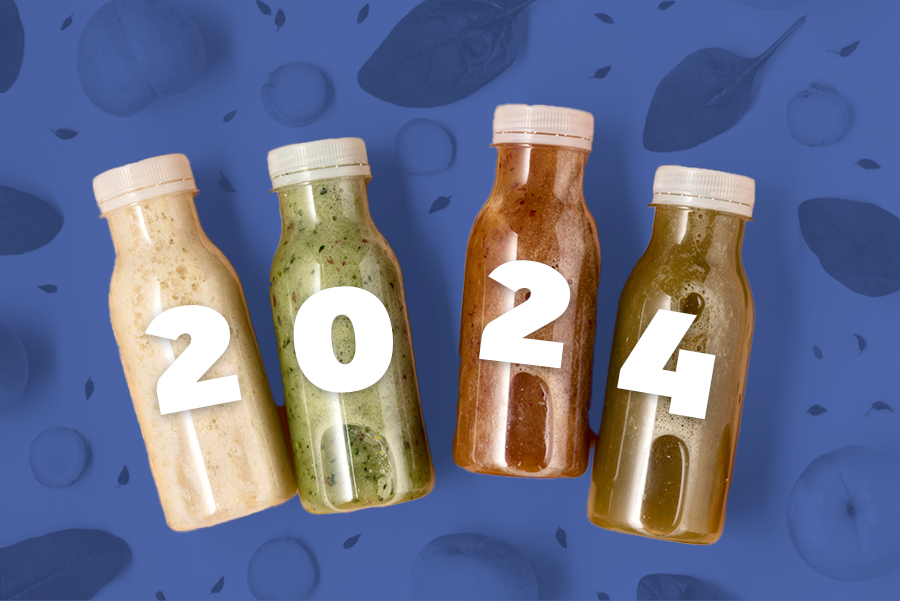It’s the time of year when we examine what is new and reflect on milestones. Trendspotting can be one of the most exciting—and polarizing—parts of consumer behaviour, especially as the industry moves into a new year.
Our intense curiosity cannot be held, we love to research and share our prophecies!
Last year’s food trends came to fruition and we saw an incredible spike in plant-based food options – and it doesn’t look like this momentum is slowing down anytime soon.
In fact, a Plant-Based Food Market Outlook report in Future Market Insights states that:
The global plant-based food market is predicted to expand by 3x, increasing from US$ 11.3 billion in 2023 to US$ 35.9 billion by 2033. Overall plant-based food sales are poised to surge at a stupendous CAGR of 12.2% between 2023 and 2033.
What can we expect the average consumer to reach for on grocery shelves in 2024?
2024 Trend-spotting
With the help of the highly-anticipated Macro Trends by natural and organic, specialty products KeHE Distributors, we were inspired to do some research. Based on our own industry experience and recent observations, our team put together a list of seven trends we think will drive product innovation and consumer demand in 2024:
Select one of the trend icons below or scroll down to learn more
1. Functional Finds
Stress management, mood balance and sleep are very high on peoples’ priority lists these days. Previously, food and beverage products delivering benefits in these areas were few and far between.
We think this will change!
Whether consumers are focusing on gut health, hydration, energy or immunity: 85% of consumers indicated that they currently look to eat or drink products that contain specific functional ingredients that offer distinct health benefits, according to Mintel 2024 Global Food and Drink Trends.
A study from New Nutrition Business also states that interest in mood and mind benefits from food skews younger, with 30% of Americans aged 25-34 motivated by these benefits, compared to just 12% of people over 65.
2. Healthy Choices and Healthy Aging
Consumers are not only concerned with their own personal health, we are seeing this health focus extend to their homes and those within their care, including children and pets.
Nutrient-dense products that limit exposure to harmful ingredients are top of mind for many consumers. As consumers become more invested in health at an earlier age than ever before, we have observed this behavioural shift translate into consumers reaching for foods that may help prevent chronic disease and illness.
Mintel's Global Food and Drink Trends for 2024 indicate:
Consumers aged 40 and over account for the most significant share of food and drink spending in many markets globally, meaning brands cannot ignore this forgotten generation. Learning from the ‘menopausal revolution’, brands should consider their various nutritional, physical, mental and emotional health needs and innovate products and formulations for issues such as cardiovascular health, brain health and stress.

3. Handpicking Quality Over Restrictions
Just because consumers are going to be making decisions based on health and disease prevention, doesn’t mean we see them giving up indulgences. Instead, we believe there will be an increase in demand for real, quality ingredients used to produce their favourite treats.
There appears to be vision beyond keto or low-fat products. Current buyers are seeking to understand the confusion surrounding fat reduction claims. U.S.-based consumer insights firm HealthFocus International found that only 21% of 18-29 year-olds thought that reducing fat was healthy, compared to 47% of those over 65.

There is a prediction that weight management claims are a thing of the past. Instead, there will be a shift in focus to initiatives like blood sugar management, fewer carbs, and increased protein. Emphasis on these properties, alongside the addition of functional food messaging, will align with the beliefs of many young consumers. These views are set to continue expanding with the support of social media influencers.
4. Social Influencers
It’s not just about TikTok feta pasta, cauliflower and corn ribs. There is an increase in social-media inspired food choices that go beyond “flavour-of-the-month” trends.
Social media platforms are swiftly encouraging young consumers to build loyalty among brand audiences. Not to mention, the celebrity-backed brands and endorsements that drive awareness and attract new customers.
International Food Information Council’s (IFIC) recent Food and Health Survey found:

While 41% said they have seen social media content on food and nutrition in the past year, the percentages were higher among Gen Z at 71% and millennials at 58% than among Gen X at 36% and baby boomers at 22%. The top social media platforms were Facebook, YouTube and Instagram. While 60% of those who came across social media content on food and nutrition said it encouraged healthier choices, 68% said they had seen conflicting information about what foods to eat or avoid.
Our social media feeds are no longer just a networking platform. Ignoring the potential of impacting an audience’s appetite from their smartphone is a lost opportunity. It's as if social media has become the main stage for accessing the latest information on nutrition and cuisine.
5. Rethinking Convenience
We are all very busy and looking for ways to make life easier, but the meaning of convenience is evolving. Because consumers are more educated and aware of what cutting-corners has historically done to the quality of our foods, we think they will be seeking meals that boost their cooking efficiency without sacrificing smart choices.
Research firm Mintel also says that 72% of consumers see heat-and-eat prepared meals as a great way to explore and try new foods and flavors.
There are loads of examples of how the COVID-19 pandemic accelerated consumers’ desires to find shortcuts to quality food and drink experiences in their day-to-day lives, and we can already see meal delivery services or virtual shopping become the norm for many households.
6. Easy Drinks
You know what else is convenient? Opening a bottle. According to Specialty Food Association (SFA) State of the Specialty Food Industry research, innovation has fueled fast paced beverage sales.
The coming year will boom with sophisticated tasting single-serve, non-alcoholic fizzy and non-fizzy drinks; and coffees, teas, and broths with functional ingredients for an additional boost of energy, clarity, focus, or calming effect," said Trendspotter Kanta Selke. Expect minimal, if any, added sugar, salt, or synthetics as well as tropical flavors and herbs and botanicals from all over the world.

Leveraged by the nutrient-dense and functional consumption trends, we predict an emergence of infused relaxation drinks, an increase in health-boosting fermented drinks, and people choosing new ways to balance function and indulgence directly from a can or bottle.
7. Mainstream Sustainability Expectations
Products with “better-for-the-planet” packaging options have been on the rise for a while now, but younger consumers will be making choices beyond this. Sustainability is no longer a niche preference, and unsurprisingly, consumers are now using their purchasing power to back sustainable products and eco-conscious companies.
One third (34%) of respondents in the previously-cited IFIC Food and Health Survey also stated that environmental sustainability highly impacts their decisions to buy food and drink.
When they were asked whether a product’s climate friendliness impacted their purchasing choices, 35% said yes. Among those, the top categories where they reported it made a difference were meat products [62%], fresh produce [55%], and dairy [50%].

In 2024, it will be commonplace to see companies making increased claims about their environmental footprint and their efforts to offset or mitigate environmental damage. Making this part of the customer journey helps reassure young and conscious customers that they're making ethical consumer choices.
Specific flavour trends we think product developers should look out for:
Whether customers are looking back wistfully for comforts from their past or looking forward to trying something new and exciting, consumers’ priorities are changing like the seasons. Here's some observations that we anticipate will make waves on the shelves.
Spicy Ranch, the kickin' condiment
The famous carrot, celery and fingie dip is evolving! Whole Foods Market’s Trends Council revealed that we may see a spicy take on the beloved ranch dip. Maybe you'll see it on your next favourite burger?
Spam, not just nostalgia
Keen to shock on social media, tinned luncheon meat and other cringe-worthy ideas are hard to look away from! They appear to be developing into unique and fun processed food viral trends
Mushrooms moving mainstream
With the mood and mind market spreading, you may have noticed mushroom foods sprouting on your social feed. During 2023 they seemed to be everyone’s new favourite snack. We predict it will also show-up in more functional foods and even more meat-alternatives and beverages
Calabrian chili peppers
These Italian bombas will offer a cultural alternative to commonplace Asian or Latin origin peppers. Datassential has also identified the growth in popularity of Calabrian peppers as an ingredient addition, alongside pickled Fresno, pickled jalapeños and ghost peppers
After digesting these trends and washing them down with your gut-supporting kombucha, we hope you keep your eye out for what the new year has in store. And in case you notice some we’ve missed: Share your thoughts in the comments!





